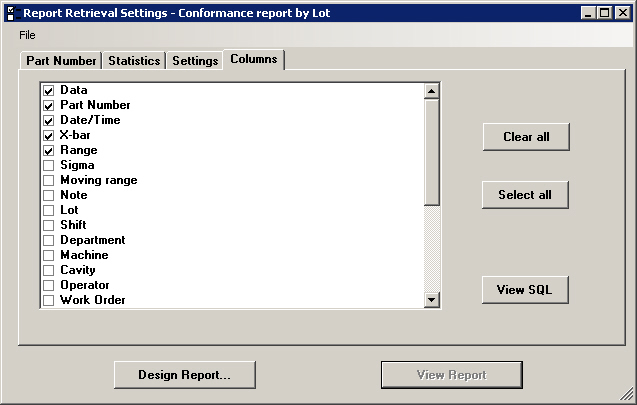
On the Columns tab of the Report Retrieval Settings screen, you can choose which columns of the raw data table (if any) to make available for the report. You an also preview the SQL query that will be used to retrieve data for the selected columns.

When you first create a new Dynamic Report, the most commonly used columns are automatically selected.
Select the check box for each column you want to provide to the report, and clear the check box for each column that is not needed for the report.
Opening a report with many columns selected will demonstrate slower performance and will use more system resources on your computer than opening a report with fewer (or no) columns. Therefore, you should select as few columns as possible to optimize the system performance when opening this report. In particular: an SPC report that includes the Note column will be slower, and a DMS report that includes the Note, Defects and/or Opportunities columns will be slower, because choosing any of these columns will add a JOIN to the SQL query.
For each data record that is retrieved for this report, GainSeeker will provide the selected columns to the report.
Most of the fields are returned as strings, including dates. To format a date field, use the ToDateTime() function on the field value.
Most strings that store numbers accept formatting for decimals. Set the decimals by entering a value in the Format property. If this does not return the wanted result, you can use the ToDouble() or Toin32() functions to convert them to numbers.
SPC: These items for SPC retrievals are not strings:
Integer:
Row Number
Real-time failures
Subgroup Size
Double:
Data
X-bar
Range
Moving Range
Sigma
DMS: These items for DMS retrievals are not strings:
Integer:
Row Number
Opportunities
Real-time Failures
Double:
p
u
Trace Cost
OEE Available
OEE Scheduled
OEE Good
OEE Total
OEE Ideal
Sample Size
Sum Defects
NCU
NCU Cost
Defects
To preview the SQL query that will be used to retrieve data for the selected columns, click View SQL. This will display the query and copy it to the clipboard. Some of the retrieval options from the Settings tab for an SPC report or the Settings tab for a DMS report will also be reflected in this query.

|